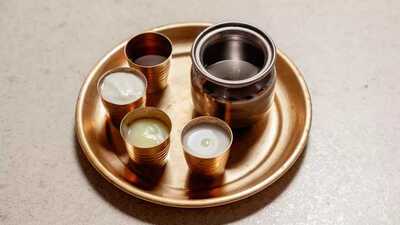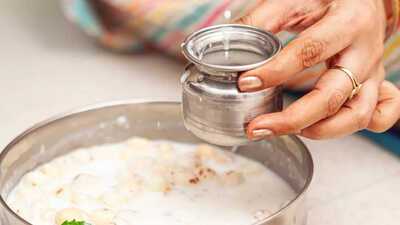The rituals of the Janmashtami festival are incomplete without the abhishek of Lord Krishna with Panchamrit. It is a holy concoction, which is offered to Lord Krishna at the midnight puja rituals of the festival and is considered to be a traditional practice associated with the festival. Let us learn more about it, its recipe, and its benefits.
Also Read: Significance of Dahi Handi celebration during Janmashtami
What is Panchamrit?
It is a sacred mixture used in Hindu rituals, especially during pujas, abhishek (ritual bathing of deities), and festive offerings. The word Panchamrit comes from Sanskrit, where panch means five and amrit means nectar of life. It’s believed that Panchamrit purifies the mind and body, nourishes the soul, and pleases the deity being worshipped. After the ritual, it’s often distributed as prasadam for everyone to drink.
What are the five ingredients used in Panchamrit?
Panchamrit is made of five ingredients, which includes milk, curd, ghee, honey, and jaggery or sugar. As per experts, milk is a symbol of purity and nurturing, curd represents prosperity and strength, ghee is for knowledge and vitality,honey represents sweetness and unity, and lastly sugar or jaggery represents bliss and happiness.

Ingredients required
1/2 up honey, 1 cup ghee, 2 cups powdered sugar, 4 cups curd, 8 cups milk
How to make it
All you need to do is combine all the ingredients in a deep mixing bowl, stir well and your panchamrit is ready. And at last it is suggested to add tulsi dal (leaves) on top of it.
What does Ayurveda say?
As per Ayurveda, Panchamrit nourishes the seven bodily tissues and enhances the body's overall immunity due to the presence of milk proteins, curd probiotics, honey's antimicrobial properties, and ghee's anti-inflammatory effects. It is said that the use of these five ingredients boost intelligence, memory, grasping power, and creative abilities too. It also acts as a natural cleanser and nourisher for skin cells, reducing stress effects and promoting a healthy glow. As per experts, it helps rectify pitta imbalances such as acidity, nausea, indigestion, and low blood pressure as well.

What study says?
According to a study, milk consumption is linked to lower risks of cardiovascular disease, stroke, hypertension, colorectal cancer, metabolic syndrome, obesity, and osteoporosis. It is also associated with reduced risks of type 2 diabetes and Alzheimer's disease. It is mentioned that honey intake helps lowering fasting blood glucose, improving cholesterol profiles, and increasing HDL levels. It also has wound-healing properties, promoting faster tissue repair and reducing infection risks due to its antimicrobial effects. If we go by PMC, curd provides important micronutrients like phosphorus, potassium, vitamins A, B2, and B12, contributing to overall nutrition. It has immunomodulatory effects, helping to strengthen the immune system. Also, curd influences the intestinal microbiota by reducing pathogenic bacteria and promoting beneficial gut flora, aiding digestion and gut health. For ghee, it is said that its decreased arachidonic acid helps lower cardiovascular disease risk.
Disclaimer: The content reflects traditional customs and the beliefs of people who observe them. It is intended to inform, not to impose or validate any particular viewpoint.
All Images Courtesy: istock
Also Read: Significance of Dahi Handi celebration during Janmashtami
What is Panchamrit?
It is a sacred mixture used in Hindu rituals, especially during pujas, abhishek (ritual bathing of deities), and festive offerings. The word Panchamrit comes from Sanskrit, where panch means five and amrit means nectar of life. It’s believed that Panchamrit purifies the mind and body, nourishes the soul, and pleases the deity being worshipped. After the ritual, it’s often distributed as prasadam for everyone to drink.
What are the five ingredients used in Panchamrit?
Panchamrit is made of five ingredients, which includes milk, curd, ghee, honey, and jaggery or sugar. As per experts, milk is a symbol of purity and nurturing, curd represents prosperity and strength, ghee is for knowledge and vitality,honey represents sweetness and unity, and lastly sugar or jaggery represents bliss and happiness.
Ingredients required
1/2 up honey, 1 cup ghee, 2 cups powdered sugar, 4 cups curd, 8 cups milk
How to make it
All you need to do is combine all the ingredients in a deep mixing bowl, stir well and your panchamrit is ready. And at last it is suggested to add tulsi dal (leaves) on top of it.
What does Ayurveda say?
As per Ayurveda, Panchamrit nourishes the seven bodily tissues and enhances the body's overall immunity due to the presence of milk proteins, curd probiotics, honey's antimicrobial properties, and ghee's anti-inflammatory effects. It is said that the use of these five ingredients boost intelligence, memory, grasping power, and creative abilities too. It also acts as a natural cleanser and nourisher for skin cells, reducing stress effects and promoting a healthy glow. As per experts, it helps rectify pitta imbalances such as acidity, nausea, indigestion, and low blood pressure as well.
What study says?
According to a study, milk consumption is linked to lower risks of cardiovascular disease, stroke, hypertension, colorectal cancer, metabolic syndrome, obesity, and osteoporosis. It is also associated with reduced risks of type 2 diabetes and Alzheimer's disease. It is mentioned that honey intake helps lowering fasting blood glucose, improving cholesterol profiles, and increasing HDL levels. It also has wound-healing properties, promoting faster tissue repair and reducing infection risks due to its antimicrobial effects. If we go by PMC, curd provides important micronutrients like phosphorus, potassium, vitamins A, B2, and B12, contributing to overall nutrition. It has immunomodulatory effects, helping to strengthen the immune system. Also, curd influences the intestinal microbiota by reducing pathogenic bacteria and promoting beneficial gut flora, aiding digestion and gut health. For ghee, it is said that its decreased arachidonic acid helps lower cardiovascular disease risk.
Disclaimer: The content reflects traditional customs and the beliefs of people who observe them. It is intended to inform, not to impose or validate any particular viewpoint.
All Images Courtesy: istock
You may also like

Pakistan: 33 killed, 25 missing due to floods and landslides

Ruben Amorim issues Andre Onana injury update and rules Man Utd duo OUT of Arsenal clash

'Best chapters of India-Israel partnership still lie ahead': Netanyahu

Lost Soul Aside release date and when you can explore the game's dark and monster-riddled world

Strictly Come Dancing's Nadiya Bychkova shares health update after horror fall







